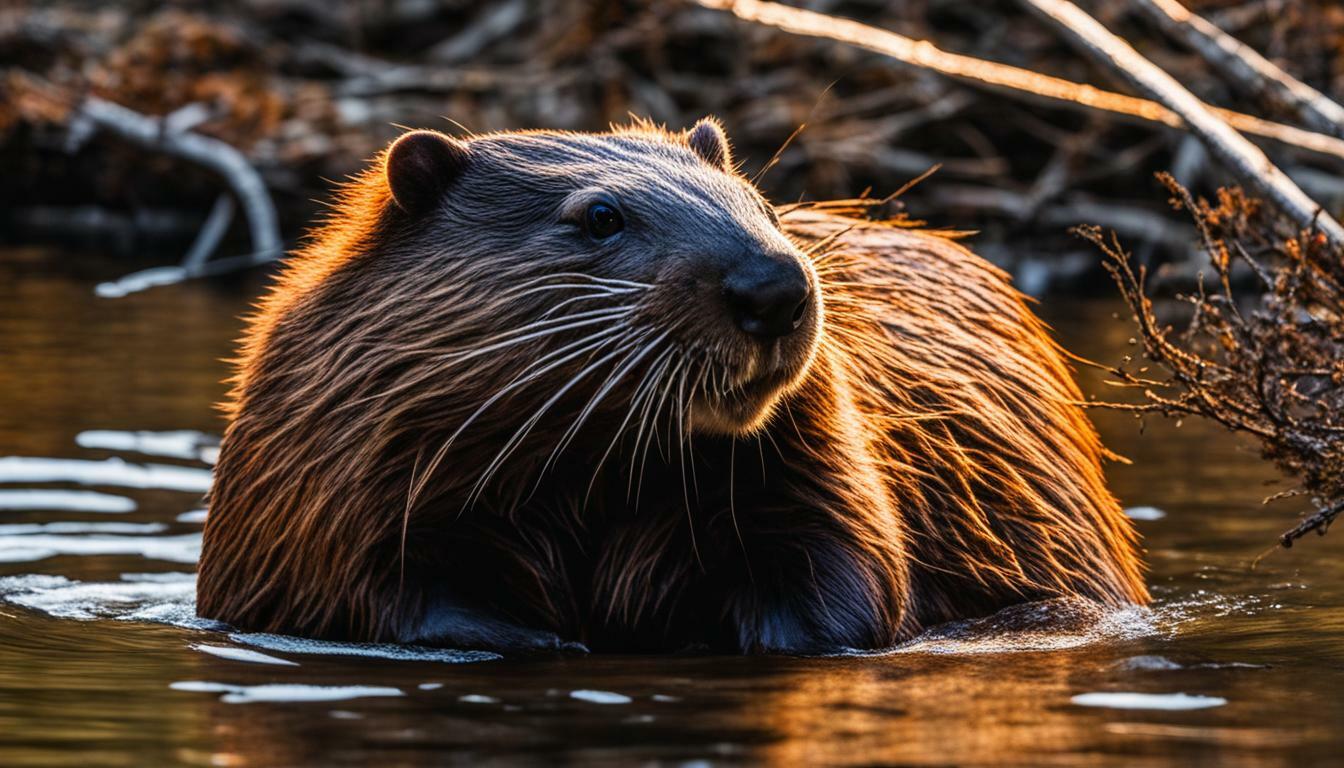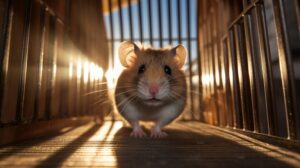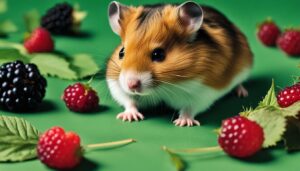Have you ever wondered why beavers have orange teeth?
Beavers have orange teeth because of the presence of iron-rich enamel, which makes their teeth stronger and more resistant to mechanical stress. The iron also gives their teeth a unique color. Beavers’ teeth constantly grow throughout their lives, and they use them to gnaw on trees and other woody vegetation. Their teeth wear down unevenly, giving them a chiseled shape that helps them cut through hard objects like wood. The orange teeth of beavers have attracted scientific interest, and researchers are studying them to potentially strengthen human teeth. Additionally, beavers are known for their ability to modify their habitat by building dams and lodges, and they are the largest rodents in North America. They are primarily nocturnal and are excellent swimmers, capable of staying underwater for several minutes.
Key Takeaways:
- Beavers have orange teeth due to the presence of iron-rich enamel.
- The iron in their teeth makes them stronger and more resistant to mechanical stress.
- Beavers’ teeth grow continuously throughout their lives.
- Their teeth wear down unevenly, giving them a chiseled shape.
- The orange teeth of beavers have attracted scientific interest and hold potential insights for human dental health.
The Iron-Rich Enamel
The secret behind the orange color of beavers’ teeth lies in the iron-rich enamel. This unique dental composition not only gives their teeth a distinct hue but also enhances their strength and durability. The presence of iron makes their teeth more resistant to the mechanical stress caused by gnawing on trees and woody vegetation, allowing beavers to thrive in their natural habitat.
Beavers’ teeth constantly grow throughout their lives, a characteristic that sets them apart from humans. This continuous growth is necessary to compensate for the wear and tear caused by their incessant chewing activities. As their teeth wear down unevenly, they develop a chiseled shape, which aids in cutting through hard objects like wood with precision.
Scientists have been captivated by the orange teeth of beavers and are studying their composition to potentially strengthen human teeth. The iron-rich enamel in beavers’ teeth holds valuable insights into tooth strength and durability, offering new possibilities for improving dental health in humans. Exploring the unique dental characteristics of beavers not only expands our knowledge of these fascinating creatures but also opens doors for advancements in dental science.
| Facts about Beavers’ Teeth | |
|---|---|
| Causes of orange teeth in beavers | Iron-rich enamel |
| Beaver dentition and orange coloration | Unique dental composition |
Constant Tooth Growth
The relentless growth of beavers’ teeth contributes to the ongoing presence of their orange shade. Unlike humans, beavers’ teeth continue to grow throughout their lives to compensate for the wear and tear caused by their incessant gnawing on trees and woody vegetation. This constant growth is a remarkable adaptation that ensures their teeth remain sharp and ready for their gnawing activities.
The continuous growth of beavers’ teeth also plays a vital role in maintaining their unique orange hue. As their teeth constantly grow, the outer layer of iron-rich enamel is consistently replenished, resulting in the distinctive orange coloration. This iron-rich enamel not only gives their teeth their signature shade but also makes them stronger and more resistant to the mechanical stress of their gnawing activities.
The never-ending growth of beavers’ teeth is a fascinating biological characteristic that highlights their remarkable dental adaptation. It allows them to sustain their vibrant orange shade, ensuring that their teeth are not only functional but also aesthetically distinct from other rodent species. This constant tooth growth is just one of the many intriguing qualities that make beavers truly fascinating creatures.
Chiseled Teeth for Cutting
The chiseled shape of beavers’ teeth plays a significant role in both their function and appearance. These unique dental structures are specifically designed to handle the rigorous demands of their habitat and feeding habits. Beavers rely on their teeth for various tasks, including cutting through trees and woody vegetation to build dams and lodges.
Due to their constant gnawing, beavers’ teeth wear down unevenly, resulting in a sharp and chiseled edge. This specialized shape allows them to effectively cut through hard objects, such as wood, with precision and ease. It is this distinctive dental characteristic that enables beavers to modify their environment and construct elaborate structures that serve as a stronghold for their colonies.
The chiseled teeth of beavers also contribute to their overall appearance. The jagged edges of their teeth not only aid in their feeding behavior but also add a rugged charm to their image. This feature sets them apart from other rodent species and showcases the remarkable adaptations found in the natural world.
| Factors | Affects Beaver Teeth Color |
|---|---|
| Gnawing Behavior | Uneven wear on teeth |
| Diet | Natural pigments in food |
| Iron Content | Presence of iron-rich enamel |
Scientific Interest and Human Applications
Scientists are fascinated by the orange teeth of beavers and are exploring ways to harness their unique qualities for human benefit. The iron-rich enamel that gives beavers their orange teeth not only makes them stronger and more resistant to mechanical stress but also holds potential applications for strengthening human teeth.
Beavers’ teeth, which constantly grow throughout their lives, are specifically adapted for gnawing on trees and woody vegetation. The uneven wear on their teeth results in a chiseled shape that allows them to effectively cut through hard objects like wood.
Researchers studying the composition and characteristics of beavers’ teeth are particularly interested in their iron-rich enamel. By unraveling the secrets of beavers’ dental attributes, scientists hope to develop insights that can be applied to human dental health. Understanding the science behind the orange teeth of beavers may lead to advancements in tooth strength and durability for humans.
| Key Points | Significance |
|---|---|
| Orange teeth due to iron-rich enamel | Strength and resilience |
| Constant growth and chiseled shape | Effective gnawing and cutting |
| Potential applications for human dental health | Advancements in tooth strength and durability |
Beavers’ natural orange tooth shade has captivated researchers and sparked curiosity about the biology and adaptations of these remarkable creatures. As we continue to delve into the science behind beavers’ teeth, we gain a greater understanding of the intricate complexities found in the animal kingdom and the potential benefits it holds for our own well-being.
Beavers’ Habitat and Behaviors
The orange teeth of beavers are closely intertwined with their habitat-modifying behaviors. Beavers are renowned for their impressive ability to modify their environment by building dams and lodges. These structures serve as their homes and provide protection from predators. Dams also create ponds that serve as a vital water source and facilitate access to food. By altering their habitat, beavers create a complex ecosystem that supports a myriad of plant and animal species.
Beavers are primarily nocturnal creatures, meaning they are most active at night. This nocturnal lifestyle allows them to avoid predators and carry out their dam-building activities undisturbed. Their exceptional swimming skills come into play as they navigate through their watery habitats. Beavers can hold their breath for several minutes, allowing them to gather materials and construct their dams underwater.
These remarkable behaviors are made possible by beavers’ unique orange teeth. Their constantly growing teeth are perfectly adapted for gnawing on trees and woody vegetation, which make up a significant portion of their diet. The chiseled, uneven shape of their teeth allows them to efficiently cut through hard materials like wood. Through their diligent dam-building activities, beavers shape and transform their surroundings, creating a habitat that supports a diverse range of plant and animal life.
| Key Facts: Beavers’ Habitat and Behaviors | |
|---|---|
| Beavers modify their environment by building dams and lodges. | Beavers are primarily nocturnal and have excellent swimming skills. |
| Their constantly growing teeth make them adept at gnawing on trees and woody vegetation. | Beavers’ dental structure allows them to cut through hard objects like wood. |
| By altering their habitat, beavers create a complex ecosystem. | Beavers’ orange teeth play a vital role in their habitat-modifying behaviors. |
Nocturnal Creatures and Excellent Swimmers
Beavers are fascinating creatures, exhibiting nocturnal tendencies and impressive aquatic capabilities. These semi-aquatic rodents are most active during the night, relying on their acute senses and adaptability to thrive in the darkness. Their keen night vision, enhanced by a reflective layer at the back of their eyes, allows them to navigate their surroundings with ease, even in low light conditions. As you observe a beaver swimming gracefully in a moonlit pond, it’s hard not to be captivated by their nocturnal prowess.
Equally remarkable is their ability to stay submerged underwater for several minutes at a time. With their powerful webbed hind feet and paddle-like tails, beavers are excellent swimmers. Their flattened tails act as rudders, aiding in navigation, while their webbed feet propel them effortlessly through the water. Whether it’s foraging for food or escaping from predators, beavers are well-equipped for an aquatic lifestyle.
In addition to their nocturnal habits and swimming prowess, beavers are known for their exceptional building skills. By constructing elaborate dams and lodges, they transform their environments to suit their needs. These structures not only create safe and cozy habitats for beavers but also have a significant impact on the surrounding ecosystem, influencing water flow and creating new habitats for diverse species of plants and animals.
| Beaver Behaviors | Descriptions |
|---|---|
| Dam-building | Beavers construct dams using branches, logs, and mud to create ponds that provide protection and easy access to food. |
| Lodge Construction | Beavers build lodges as their living quarters, using sticks and mud to create a dome-shaped structure with underwater entrances. |
| Food Storage | Beavers store food underwater near their lodges by anchoring it to the pond bottom, ensuring a readily available food supply during winter. |
Next time you spot a beaver at dusk or witness its remarkable swimming abilities, take a moment to appreciate the beauty and adaptability of these creatures. From their nocturnal habits to their masterful engineering skills, beavers are a true marvel of nature.
The Largest Rodents in North America
Towering over their rodent relatives, beavers claim the crown as the largest rodents in North America. These fascinating creatures are known for their unique dental characteristics, including their orange teeth.
Beavers’ teeth have a distinctive orange hue due to the presence of iron-rich enamel. This enamel not only gives their teeth their unique color, but also makes them stronger and more resistant to the mechanical stress of their gnawing activities. The iron content in their teeth is a remarkable adaptation that sets them apart from other rodents.
One of the reasons why beavers’ teeth stand out is their constant growth. Unlike human teeth, which stop growing after a certain point, beavers’ teeth continue to grow throughout their lives. This continuous growth is necessary to compensate for the wear and tear caused by their incessant gnawing on trees and woody vegetation. The orange hue of their teeth is a result of this continuous growth and is a fascinating aspect of their dental biology.
Beavers’ teeth wear down unevenly, resulting in a chiseled shape. This chiseled shape is an important adaptation that allows them to effectively cut through hard objects like wood. The unique coloration of their teeth is closely linked to this chiseled shape, making their dental structure a true marvel of nature.
| Key Points: |
|---|
| Beavers have orange teeth due to the presence of iron-rich enamel |
| Their teeth constantly grow throughout their lives to compensate for wear and tear |
| The chiseled shape of their teeth helps them cut through hard objects |
A Closer Look at Beavers’ Teeth
Diving deeper, we will explore the intricacies of beavers’ teeth, unraveling the secrets behind their orange hue. Beavers have orange teeth due to the presence of iron-rich enamel, which not only gives their teeth a unique color but also makes them stronger and more resistant to mechanical stress. This iron-rich enamel is a crucial adaptation that allows beavers to gnaw through trees and woody vegetation, their primary source of food and building materials.
Unlike humans, beavers’ teeth constantly grow throughout their lives. This continuous growth is necessary to compensate for the wear and tear caused by their incessant gnawing activities. As their teeth wear down unevenly, they develop a chiseled shape, which enables beavers to effectively cut through hard objects like wood. It’s this chiseled shape that contributes to the distinct orange coloration of their teeth.
Researchers have taken a keen interest in the orange teeth of beavers, studying their composition and characteristics. The unique properties of beavers’ teeth, such as their iron-rich enamel and constant growth, have potential implications for human dental health. By understanding the science behind beavers’ orange teeth, scientists aim to uncover insights that could enhance the strength and durability of human teeth.
| Key Points: |
|---|
| Beavers have orange teeth due to iron-rich enamel. |
| Their teeth constantly grow to compensate for wear and tear. |
| The chiseled shape of their teeth helps in cutting through hard objects. |
| Researchers are studying beavers’ teeth for potential dental applications in humans. |
Practical Implications of Beavers’ Teeth
Beavers’ teeth have practical implications that extend beyond their own species and have attracted the interest of researchers. The unique dental characteristics of beavers, including their orange color and constant growth, hold potential insights for human dental health. Scientists are studying the composition and structure of beavers’ teeth to explore their applications in strengthening human teeth.
One of the key factors contributing to the practical implications of beavers’ teeth is their iron-rich enamel. This enamel not only gives their teeth a distinct color but also makes them stronger and more resistant to mechanical stress. By understanding the science behind the orange teeth of beavers, researchers hope to develop new approaches to enhance the strength and durability of human teeth.
The continuous growth of beavers’ teeth is another fascinating aspect that has practical implications. Unlike humans, whose teeth stop growing after a certain point, beavers’ teeth grow constantly throughout their lives. This growth is necessary to compensate for the wear and tear caused by their incessant gnawing on trees and woody vegetation. By studying the growth patterns of beavers’ teeth, researchers aim to uncover mechanisms that can promote tooth regeneration and longevity in humans.
| Benefits of Beavers’ Teeth | Implications for Human Dental Health |
|---|---|
| Strength and durability due to iron-rich enamel | Potential insights for enhancing human tooth strength |
| Constant growth to compensate for wear and tear | Potential mechanisms for promoting tooth regeneration in humans |
The practical implications of beavers’ teeth extend beyond their physical attributes. Beavers are known for their ability to modify their habitat by building dams and lodges. Their teeth play a critical role in these activities, allowing them to fell trees and construct their elaborate structures. By studying the behavior and dental adaptations of beavers, researchers aim to gain insights into construction and engineering techniques that could have practical applications in various fields.
Overall, the orange teeth of beavers are not only a remarkable natural phenomenon but also hold significant potential for human dental health and other practical applications. Through ongoing research and exploration, scientists strive to unlock the secrets behind beavers’ teeth, paving the way for innovative advancements in dental care and engineering.
The Fascinating Biology of Beavers
To truly comprehend the phenomenon of orange teeth in beavers, we must delve into their intriguing biology. These remarkable creatures possess a unique adaptation that sets them apart from other rodents.
Beavers have orange teeth due to the presence of iron-rich enamel. This enamel not only gives their teeth a distinct color but also makes them stronger and more resistant to the mechanical stress of gnawing. The iron in their teeth acts as a natural reinforcement, allowing them to efficiently chew through wood and other tough materials.
Beavers’ teeth constantly grow throughout their lives, a trait that is essential for their survival. As they gnaw on trees and woody vegetation, their teeth wear down unevenly, resulting in a chiseled shape. This chiseled shape allows them to effectively cut through hard objects, providing them with the necessary tools for building their dams and lodges.
| Causes of Orange Teeth in Beavers | Factors Affecting Beaver Teeth Color |
|---|---|
| Presence of iron-rich enamel | Wear and tear from constant gnawing |
| Continuous growth of teeth | Nutritional factors |
| Chiseled shape of teeth | Genetic variations |
The orange teeth of beavers have attracted scientific interest, as researchers seek to understand the underlying mechanisms behind their unique dental composition. This research not only deepens our understanding of beavers’ natural adaptations but also holds potential insights for strengthening human teeth and improving dental health.
Furthermore, beavers are renowned for their ability to modify their habitat by building dams and lodges. This behavior showcases their remarkable instinctive engineering skills and highlights the crucial role their teeth play in these activities. As the largest rodents in North America, beavers have carved a niche for themselves in the animal kingdom with their fascinating biology and distinctive dental characteristics.
Conclusion
The captivating mystery of why beavers have orange teeth has been unraveled, revealing a fascinating blend of science and adaptation. These remarkable rodents owe their unique dental hue to the presence of iron-rich enamel, which not only gives their teeth strength and resilience but also imparts a distinct color.
Beavers’ teeth constantly grow throughout their lives, a necessary adaptation to compensate for the wear and tear caused by their gnawing activities. Their unevenly worn teeth take on a chiseled shape, enabling them to effectively cut through hard objects such as wood.
Scientists have shown a keen interest in beavers’ orange teeth, with ongoing research focused on understanding their dental composition. The insights gained may have potential applications in strengthening human teeth and improving dental health.
Aside from their dental marvels, beavers are known for their ability to reshape their habitat by constructing dams and lodges. These nocturnal creatures are excellent swimmers, with the ability to stay submerged underwater for extended periods. As the largest rodents in North America, beavers are truly remarkable creatures that continue to fascinate researchers and nature enthusiasts alike.
FAQ
Why do beavers have orange teeth?
Beavers have orange teeth because of the presence of iron-rich enamel, which gives their teeth strength and a unique color.
How do beavers’ teeth constantly grow?
Beavers’ teeth grow continuously throughout their lives to compensate for the wear and tear caused by gnawing on trees and woody vegetation.
Why do beavers’ teeth have a chiseled shape?
Beavers’ teeth wear down unevenly, resulting in a chiseled shape that helps them cut through hard objects like wood.
Why are scientists studying beavers’ teeth?
Scientists are studying beavers’ teeth to potentially strengthen human teeth and understand the composition and characteristics of their dental structure.
What are some other interesting facts about beavers?
Beavers are known for their ability to modify their habitat, they are the largest rodents in North America, and they are primarily nocturnal and excellent swimmers.




